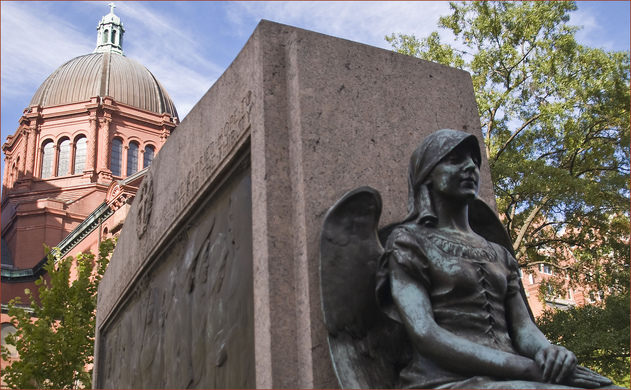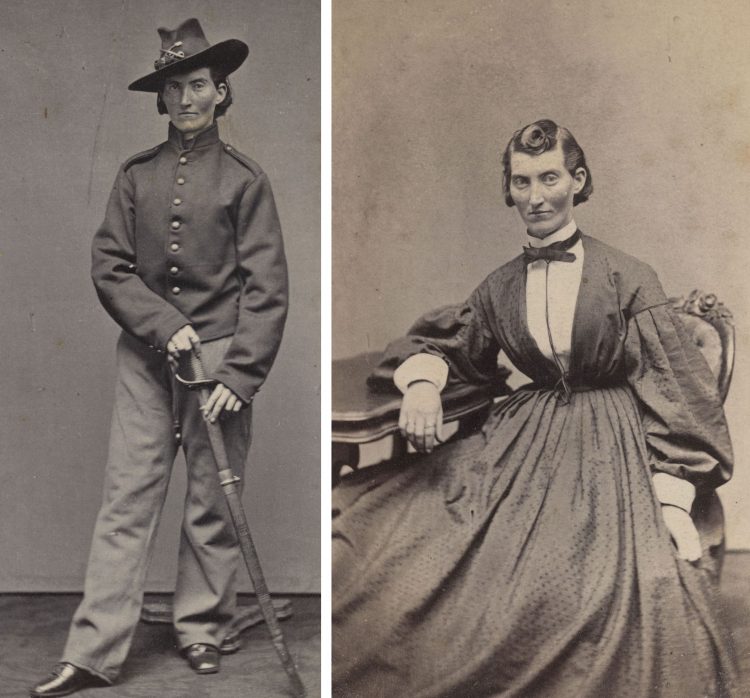National Day of Thanksgiving The first Thanksgiving dinner was held by the Pilgrims in October 1621, as a harvest festival in Plymouth Colony. President George Washington declared a day of Thanksgiving for the new nation in 1789, and another in 1795. Image: Thanksgiving in Camp Drawing by Alfred R. Waud Thursday November 28, 1861 However, our national day of Thanksgiving came not from the Pilgrims, but from President Abraham Lincoln during the Civil War, and from Sarah Josepha Hale, the editor of a popular women’s magazine, Godey’s Lady’s Book. For 40 years Hale had written editorials and letters to governors and presidents, trying to have Thanksgiving declared a holiday. Sarah Josepha Hale, born in 1788, was also known for her…

Union Nurses of the Civil War
Women Who Served as Nurses for the Union Army Soon after the Civil War began, the United States government established the Army Nursing Service and appointed Dorothea Dix as its Superintendent of Women Nurses. The 60-year-old Dix quickly established stringent qualifications for her volunteer nurses. Image: Civil War Nurses Memorial Washington, DC Each nursing candidate had to be “past 30 years of age, healthy, plain almost to repulsion in dress and devoid of personal attractions.” They had to be able “to cook all kinds of low diet” and avoid “colored dresses, hoops, curls, jewelry and flowers on their bonnets.” They could not associate with either surgeons or patients socially, and they must always insist upon their rights as the senior…
Nursing in the Civil War South
Volunteer Confederate Nurses American nursing was still in its infancy at the outbreak of the Civil War. In the antebellum South, women usually served as nurses within their own families. On large plantations, the master’s wife nursed her husband, children, and slaves. Many Southern women were already accustomed to caring for ill patients, and nursing was considered a woman’s duty. Image: Artist’s Sketch of a Civil War Hospital Still, it was not a job that ladies of breeding and stature would volunteer for. The Southern woman was regarded as delicate and modest. When Fort Sumter was fired upon, and the wounded and dying came pouring in from the battlefields, the South found itself unprepared to care for its casualties. The…
Linda Richards
America’s First Trained Nurse Linda Richards (1841–1930) was the first professionally trained nurse in the United States. Her experiences with nursing her dying mother and her husband, who was wounded in the Civil War, inspired Richards to become a nurse. She was the first student to enroll in the first nurse training school at the New England Hospital for Women and Children in 1872. She established nurse training programs in the United States and Japan, and created the first system for keeping individual medical records for hospitalized patients. Linda Richards was born on July 27, 1841, the youngest daughter of Sanford Richards, an itinerant preacher who christened her Malinda Ann Judson Richards by her father, in hopes she would someday…
Caroline Gilman
Novelist, Poet and Magazine Editor Caroline Gilman was one of the most popular women writers of the nineteenth century. Despite her northern origins, Caroline Gilman’s loyalties gradually shifted toward the South, and she became known as an important southern woman writer during the 1830s and 1840s. Her books promoted domestic tranquility as a solution not only for her heroines’ ills but also for those of the nation. Caroline Howard was born in Boston on October 1, 1794. Her parents were prosperous and well-connected. Her father died when she was two, and she was raised by an older sister after her mother’s death in 1804. Her formal education was limited, but Caroline developed an early interest in literature. She wrote poetry…
Mary Bedinger Mitchell
Mary Bedinger Mitchell was born August 3, 1850. Her father, Henry Bedinger, served as America’s first ambassador to Denmark. In 1858, the family went to Shepherdstown, Virginia (now West Virginia), where Henry had grown up. In the 1840s, he came down with pneumonia after giving a speech to a cheering crowd. He died two weeks later. Mary Bedinger Mitchell The family lived for a while with her father’s sister, Henrietta Bedinger Lee, and her husband, Edmund Jennings Lee, the first cousin of Robert E. Lee. In 1859, Mary’s mother bought “Poplar Grove,” near Shepherdstown and had an addition built onto the house. She also hired a tutor to teach her children at home. After the Battle of Antietam, which occurred…
Louisa Volker
Woman Telegraph Operator in Missouri Louisa Volker became a Union telegrapher in Missouri during the Civil War. Her intelligence activities put her at risk of capture because Confederate raiders in the area often kidnapped the local telegrapher when they invaded a town, and forced him to intercept messages from, or send false reports to, the enemy. Louisa Volker was born in St. Louis, Missouri, in 1838, the daughter of German immigrants. Her father Emanuel Volker was a grocer. Louisa had an older sister, two younger sisters and a brother. In the 1840s, Emanuel Volker purchased land in the city of St. Louis and surrounding counties. In the 1850s, the female members of the family, including Louisa, participated in these land…

Female Soldiers of the Civil War
Women Soldiers in the Civil War On September 17, 1862 at least four women fought at the Battle of Antietam. With more than 30,000 casualties, it was the single bloodiest day of the Civil War. At this bridge, Union troops under General Ambrose Burnside took heavy casualties. Both the Union and Confederate armies forbade the enlistment of women. So women who wanted to serve disguised themselves as men and assumed masculine names. Because many of them successfully passed as men, it is impossible to know with any certainty how many women served in the Civil War. The estimate is somewhere between 400 and 1000. I think even the larger number might be an understatement. Women who were determined to fight…
Jane Howison Beale
Civil War Diarist and Educator Image: Widow Jane Howison Beale, Fredericksburg’s most prominent woman, lived in this home at the corner of Lewis and Charles Streets, and left a vivid account of the town during the Civil War. She was among the many who fled during the shelling from Federal artillery. Early Years Jane Howison was born in Fredericksburg, Virginia, in 1815, one of twelve children. Her parents, Samuel and Helen Moore Howison, were prominent members of the community. At the age of nineteen, Jane married William Churchill Beale. In 1846, William bought a large brick home in Fredericksburg. William died suddenly and unexpectedly of a heart attack in 1850, leaving Jane to cope with their large family alone. And…
Amanda Smith
African American Evangelist and Missionary Amanda Berry Smith, a preacher and missionary, was a former slave who became an inspiration to thousands of women both black and white. During a forty-five-year missionary career of arduous travel on four continents, this self-educated former slave and washerwoman became a highly visible and well-respected leader despite intense opposition to women in public ministry, a crescendo of white racist violence and the tightening grip of segregation. Childhood Amanda Berry was born in born a slave at Long Green, Maryland on January 23, 1837. Her father, a slave, worked for years at night and after long days of field labor, he made brooms and husk mats to earn enough money to buy the freedom of…